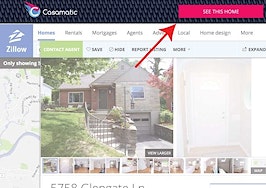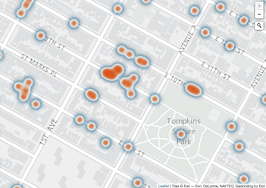Homes.com announced today that it’s adding school ratings to listing pages. The school scores range from “A+” to “D” and are calculated by comparing a public school’s performance data to the performance data of other schools in its state.
That brings the site up to speed with competitors that have long displayed school ratings, including Zillow, Trulia and realtor.com. Some listing portals even serve up school attendance zone boundaries. (Homes.com currently doesn’t.)
Sometimes overshadowed by Zillow, Trulia and realtor.com, Homes has recently placed a focus on helping prospective buyers get a better feel for neighborhoods online.
The portal is playing catch-up with competitors in adding some types of community data to its search experience.
But it’s also working on adding features that could give it an edge over competitors that have traditionally done a better job of providing local color.
Homes.com also added a commute-time calculator to its listing pages in October of last year. That feature has grown in popularity, but it’s less common on real estate search sites than school scores. Trulia’s got it, but realtor.com and Zillow do not.

OpenSignal map showing Verizon’s mobile coverage of New Canaan, Connecticut. Homes.com is experimenting with adding such maps to its search experience.
Weaving those features into its search experience has helped Homes.com paint portraits of neighborhoods that are close to or equally as vivid as those that appear on leading listing sites.
But in what may be a first for the listing portal, the firm is poised to introduce neighborhood data that buyers can’t currently find on any other listing search sites: mobile coverage maps.
The maps are provided by OpenSignal, which keeps a database of cellphone towers, cellphone signal strength readings and Wi-Fi access points.
They could help buyers and renters factor an area’s cell coverage into their evaluation of a listing or identify what network provider they might want to sign up with were they to move into a particular home, Jaleh Afrooze, operations manager at OpenSignal, recently told Inman.
Patty McNease, director of marketing at Homes.com, said that the listing portal is testing the maps to see if the visualizations engage users, and will provide more information if Homes.com decides to use the maps.
Homes.com claimed around 2.67 percent of all mobile and desktop real estate search traffic in April, according to Experian.
That made it the fifth most popular listing portal. Zillow commanded the most visits in April (21.82 percent), followed by realtor.com (10.71 percent), Trulia (8.92 percent) and Yahoo! Homes (2.7 percent).
If it wants to climb those rankings, Homes.com faces an uphill battle. Unlike some of its competitors, the listing portal is not pouring tens of millions of dollars into marketing campaigns.
But introducing state-of-the-art functionality into its search experience, and even pioneering some features, may be a good start.








